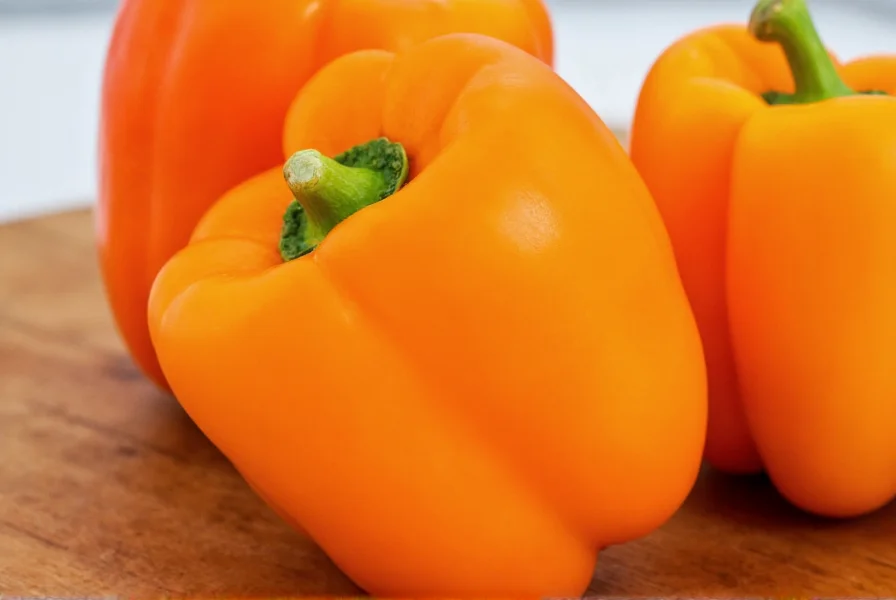When exploring the vibrant world of bell peppers, the orange variety stands out as a nutritional powerhouse with distinctive flavor characteristics. These peppers represent an intermediate ripening stage between green and red peppers, though some cultivars naturally mature to orange without progressing to red. Understanding what makes orange peppers unique helps home cooks and health-conscious eaters make informed choices.
The Science Behind Orange Peppers
Orange bell peppers develop their characteristic color through a natural ripening process. As green peppers mature on the plant, chlorophyll breaks down while carotenoids—particularly beta-carotene and beta-cryptoxanthin—accumulate. This biochemical transformation not only changes the color but also enhances both flavor and nutritional profile.
The University of Florida Institute of Food and Agricultural Sciences (IFAS) documents the precise ripening timeline: bell peppers transition from green harvest stage (65-70 days post-transplant) to orange maturity at approximately 80 days, with this extended development period enabling critical phytochemical synthesis. This timeline explains both the flavor evolution and higher production costs compared to early-harvest green peppers. Some specialty cultivars like "Sweetie Orange" and "Orange Sun" naturally mature to orange without progressing to red. (Source: University of Florida IFAS HS149)

Nutritional Comparison Across Pepper Colors
Orange peppers offer significant nutritional advantages over less mature varieties. The ripening process increases both sugar content and beneficial phytochemicals. Consider these key nutritional differences per 100g serving:
| Nutrient | Green Pepper | Orange Pepper | Red Pepper |
|---|---|---|---|
| Vitamin C (mg) | 80 | 180 | 190 |
| Vitamin A (IU) | 370 | 7400 | 9500 |
| Beta-carotene (mcg) | 157 | 4200 | 5600 |
| Sugar (g) | 2.4 | 4.2 | 4.2 |
This nutritional progression demonstrates why fully ripened peppers provide greater health benefits. The nutritional benefits of orange bell peppers include enhanced antioxidant capacity compared to green varieties while maintaining a slightly different phytochemical profile than red peppers.
Flavor Profile and Culinary Applications
Orange peppers deliver a distinctive flavor profile that makes them versatile in the kitchen. They offer approximately 30% more sugar than green peppers while maintaining less intense sweetness than red varieties. This balanced sweetness makes them particularly suitable for:
- Raw applications where milder flavor is preferred
- Stir-fries that benefit from subtle sweetness
- Roasting to enhance natural sugars without caramelizing too quickly
- Blending into sauces where orange color complements other ingredients
When considering how to use orange peppers in cooking, remember they maintain better texture than red peppers when cooked briefly, making them ideal for dishes requiring distinct pepper pieces rather than melted sweetness. However, their higher sugar content creates specific limitations: as noted by the University of Minnesota Extension, orange peppers are more susceptible to burning during high-heat searing and have reduced structural integrity in slow-cooked dishes compared to green varieties. (Source: University of Minnesota Extension)
Selecting and Storing for Maximum Freshness
Choosing quality orange peppers involves several key indicators. Look for firm, glossy skin with three or four lobes at the base—peppers with more lobes often contain more seeds but also greater sweetness. Avoid specimens with wrinkles, soft spots, or dull coloring.
Proper storage significantly extends shelf life, though critical context boundaries exist. While all bell peppers benefit from high-humidity crisper drawer storage, the University of Minnesota Extension specifies that orange peppers maintain quality for only 1-2 weeks (compared to 1-3 weeks for green varieties) due to accelerated enzymatic degradation from higher sugar content. For longer preservation, slice and freeze peppers on a baking sheet before transferring to airtight containers—this method preserves texture better than freezing whole. (Source: University of Minnesota Extension)

Evidence-Based Health Benefits
The health benefits of eating orange peppers stem primarily from their rich carotenoid content. Beta-cryptoxanthin, more abundant in orange than red peppers, has demonstrated anti-inflammatory properties in clinical studies. Research published in the Journal of Agricultural and Food Chemistry indicates orange peppers provide unique antioxidant combinations not found in other colors.
Regular consumption supports eye health through lutein and zeaxanthin content, while the substantial vitamin C boost enhances immune function and collagen production. Unlike supplements, the natural matrix of nutrients in whole peppers improves bioavailability of these compounds.











 浙公网安备
33010002000092号
浙公网安备
33010002000092号 浙B2-20120091-4
浙B2-20120091-4